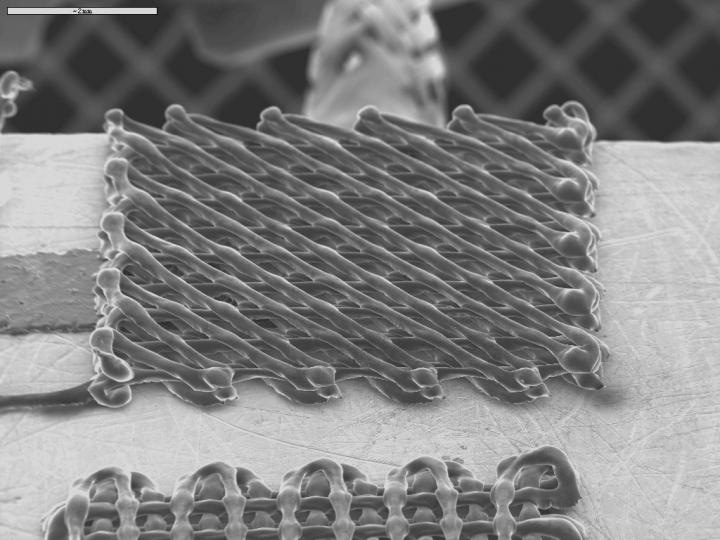Jan 11 2017
 As soon as it comes out of the printing nozzle, the solvent evaporates and the ink solidifies. It takes the form of filaments slightly bigger than a hair. The manufacturing work can then begin. (Credit - Polytechnique Montreal)
As soon as it comes out of the printing nozzle, the solvent evaporates and the ink solidifies. It takes the form of filaments slightly bigger than a hair. The manufacturing work can then begin. (Credit - Polytechnique Montreal)
Both carbon nanotubes and 3D printing have made headlines in scientific journals for a while now. Something unique happens when both are combined with the right polymer, in this case a thermoplastic. Electrical conductivity increases, enabling monitoring of liquids in real time. This is a big achievement for Polytechnique Montréal.
The research paper titled “3D Printing of Highly Conductive Nanocomposites for the Functional Optimization of Liquid Sensors” was published in the journal Small on November 23, 2016. Small, a journal well-known in the field of micro-and nanotechnology, put the research paper on its back cover, a sure sign of the significance of the research undertaken by mechanical engineer Professor Daniel Therriault and his team.
In practical terms, the result of this research resembles a cloth; but the moment a liquid touches it, said cloth is capable of identifying its nature. In this case, it is ethanol, but it could have been another liquid. This kind of a process would be a great advantage to heavy industry, which uses numerous hazardous liquids.
A simple yet efficient recipe
While deceptively simple, the method is so efficient that Professor Therriault protected it with a patent. A U.S. company is in fact looking to commercialize this material printable in 3D, which is highly conductive and has a variety of potential applications.
A thermoplastic is taken and transformed into a solution using a solvent so that it becomes a liquid. Next, due to the porousness of this thermoplastic solution, it is possible to add carbon nanotubes into it like never before, in a similar manner like adding sugar into a cake mix.
The result is a sort of black ink that is somewhat viscous and whose very high conductivity approximates that of certain metals. Finally, this black ink, which is actually a nanocomposite, can now be transferred to 3D printing. The solvent evaporates and the ink solidifies directly after it comes out of the printing nozzle. It forms into filament shape, a little bigger than a hair. The manufacturing process can then start.
The advantages of this technology
The research conducted at Polytechnique Montréal is at the forefront in the field of applications for 3D printers. The age of basic prototyping, like printing small plastic objects, is a thing of the past. These days, all manufacturing industries from aviation and aerospace to robotics and medicine are keen on using this technology.
There are many reasons for this. The lightness of parts as plastic replaces metal. The precision of the work realized at the microscopic level. With the nanocomposite filaments that can be used at room temperature, conductivities can be obtained that approximate the conductivities of certain metals.
Even better is the fact that the geometry of filaments can be varied, and measures can be calibrated, which makes it possible to read a range of electric signatures of liquids that are to be observed.
A topical example: pipelines
There are flanges at the connection points of pipes that form pipelines. The plan is to factory-manufacture the pipes with flanges coated using 3D printing.
The coating is a nanocomposite whose electric signature is calibrated based on the liquid being transported – oil, for example.
In case there is a leak and the liquid makes contact with the printed sensors based on the concept formulated by Professor Therriault and his team, an alert would be raised in record time, and in a highly targeted manner. That is a huge advantage, both for people and the environment. Quicker reaction time means lesser damages in case of a leak.
Professor Therriault’s research is supported by Centre de recherche sur les systèmes polymères et composites à haute performance (Research Centre for High-Performance Polymer and Composite Systems – CREPEC), the Canada Research Chairs, the Natural Sciences and Engineering Research Council of Canada (NSERC), Mitacs and the Canada Foundation for Innovation (CFI).